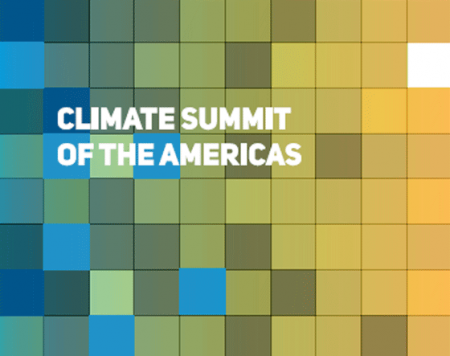July 10, 2015 – In conjunction with the Pan-American and Parapan Games being held in Toronto starting today, leaders from the participating countries including sub-national jurisdictions have come together in a climate summit this week.
Led by California, Ontario, Quebec and British Columbia who put out a joint climate change statement committing themselves to collaborate on policies to reduce greenhouse gas emissions. All four set 2020 emission targets and agreed to collaborate on “mid-term greenhouse gas emissions reductions to maintain momentum toward 2050 targets” which they jointly will establish prior to the 2015 Conference in Paris. Joining these four are Vermont, Oregon, the city of Sao Paulo and 14 other jurisdictions who all agreed to band together to institute aggressive policies to limit global warming to less than 2 Celsius (3.6 Fahrenheit) degrees, the target the IPCC has established as one that would keep the impact of a warming planet to a workable minimum.
Mexico’s Felipe Calderon, chair of the Global Commission on the Economy and Climate, spoke at the summit and reported that 2014 was the first time in four decades that global GDP grew 3% without growth in greenhouse gas (GHG) emissions.
The commission which he heads is focused on transitioning the world to a low-carbon future. Among its recommendations are:
- Investing in climate-smart infrastructure to reduce urban carbon footprint while recognizing that it is cities where 60% of us will live by 2030.
- Restoring agricultural and forest landscapes using a holistic approach to both address future food requirements and the need to expand natural carbon sinks.
- Investing a trillion dollars every year in clean energy for the next 15 years.
- Raising energy efficiency standards to reduce the demand to build additional energy capacity.
- Implementing global carbon pricing that rises predictably and acts in an efficient way to meet climate and fiscal objectives.
- Investing in low-carbon innovation, recycling, conservation and energy efficiency.
- Driving low-carbon growth through government policy, business and investment and through initiatives by corporations to integrate climate change within business models.
- Reducing international aviation and maritime emissions projected to rise 10 to 32% by 2050 by developing new design and efficiency standards into global fleets.
- Phasing down hydrofluorocarbons which despite international agreements continue to rise 10 to 15% per year and remain a threat to the ozone layer in the upper atmosphere.
Present at the climate summit event – Al Gore who framed his speech in three parts, “Must we change? Can we change? Will we change? and described daily news reports on the environment as “a nature hike through the Book of Revelation.”
Not present – the federal government of Canada whose spokesperson touted the government’s success to date in reducing GHGs without putting a price on carbon which the government describes as a job killer. Of course, the spokesperson’s position is far from the truth. Canada’s GHGs have flat-lined rather than fallen, and are expected to rise over the next decade as more oil sands capacity comes online. Only the sub-jurisdictions – Quebec, Ontario and British Columbia have seen emissions drop and they are the ones who are implementing a price on carbon.



















